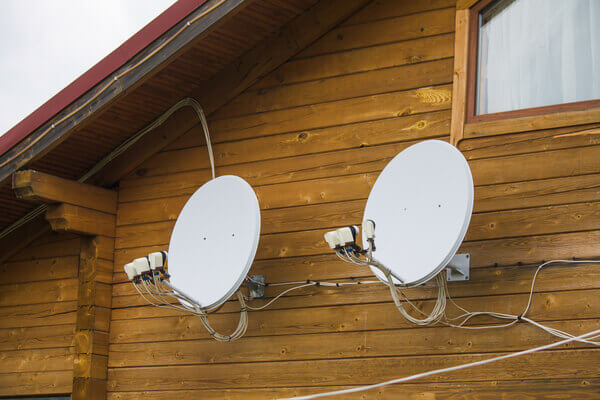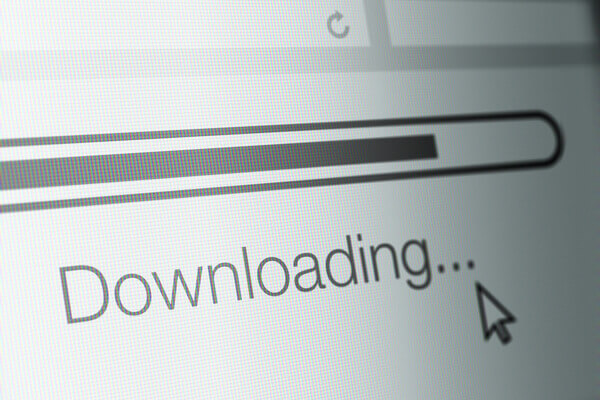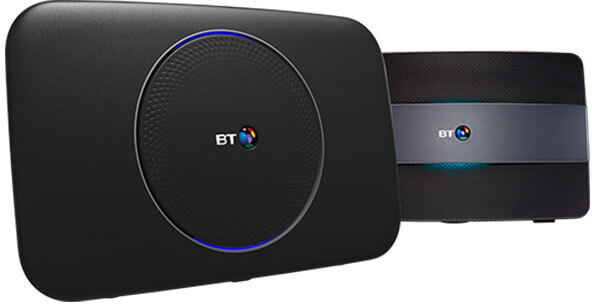Broadband jargon
 Dan Howdle • October 17th, 2024
Dan Howdle • October 17th, 2024

Let's be honest, technology is still pretty bad at explaining itself through the language we have to use to describe it – abbreviations and confusing, made-up words are everywhere. Broadband unfortunately is no different. So here, we offer you a simple glossary of terms with definitions everyone can understand.
In this guide...

Types of broadband
- 4G – The four is simply the generational number for mobile phones. The first mobile networks were 1G (voice only), then 2G (voice and text), then 3G (voice text and internet), then 4G (voice, text and fast internet). So 4G simply means fourth generation mobile network
- ADSL – Stands for Asymmetric Digital Subscriber Line. This is standard broadband delivered over a copper telephone line. Download speeds tend to be faster the closer you live to your local telephone exchange, but average out at about 10Mbps
- ADSL2+ – Still over copper lines, but capable of delivering up to 24Mbps. Not fibre, but the fastest form of ADSL
- Broadband – A high-speed internet connection, which can be delivered in a number of ways but is distinct from the old dial-up or ‘narrowband’ connections
- Cable broadband – Broadband delivered in the UK via an upgraded network of coaxial cables previously used to deliver cable TV. Virgin Media is the only provider to offer this sort of broadband
- Dial-up or narrowband – Hardly, if ever, used in the UK anymore but it’s how we got online in the 1990s. It’s internet access via a modem that literally dials up the provider over a phone line, so you can’t use the internet and the phone at the same time
- Fibre broadband – Broadband delivered over cables that are, at least for part of the network, fibre optic in nature. Fibre optic cables transmit signals as light through glass, which is capable of far faster rates of data transfer than traditional ADSL connection where the cables are made of copper
- Fixed line – Any broadband delivered using a physical cable, such as fibre or ADSL. The alternative would be mobile or satellite broadband, both of which transmit data wirelessly
- Full Fibre – The term used by Openreach and BT for the latest fibre-to-the-premises (FTTP) broadband services. It's a naming convention that's beginning to be used more widely in the industry and by some other providers. Some alternative names you may also see used are ‘Pure Fibre’, 'Future Fibre', 'Fibre Max' and possibly 'Ultrafast' – they often mean the same thing
- Gigabit broadband – A broadband connection which delivers up to or around 1,000Mbps. 1,000 megabits equals one gigabit, hence gigabit broadband. It is also commonly referred to as ultrafast broadband
- Leased line – A dedicated connection typically between a business premises and the local exchange. Leased lines offer a symmetrical connection (i.e. with the same download and upload speeds) with no contention (i.e. they are not shared with other users)
- LTE – Stands for Long Term Evolution. It's not a new term you need to learn since it means exactly the same thing as 4G
- Mobile broadband – High-speed internet access delivered via a mobile network, as opposed to a fixed line
- Satellite broadband – Is broadband delivered by satellite dish. Traditionally, the only households making use of satellite broadband are those few properties dotted about the country where literally no other option is possible. Satellite broadband has some major drawbacks: it's expensive, limited, and suffers from latency that makes online gaming impossible
- SDSL – Stands for Symmetrical Digital Subscriber Line. Achieves equal upload and download speeds, unlike an ADSL connection, but is still delivered over copper telephone wires
- Superfast broadband – Broadband that exceeds 24Mbps, but is slower than 300Mbps. If it's less than 24Mbps, it's just 'broadband' and if it's faster than 300Mbps, it's 'ultrafast broadband'
- Symmetrical and asymmetrical broadband – Most broadband services offer significantly higher download speeds than upload speeds – these are asymmetrical connections. Symmetrical broadband provides the same speed for uploads and downloads
- Unlimited broadband – Any broadband connection where there is no limit on the amount of data you can download and/or upload on a monthly basis. All broadband packages except some satellite and 4G/5G broadband packages in the UK come with unlimited usage
- Ultrafast broadband – Typically refers to broadband services offering speeds of at least 100Mbps. This is the definition used by the UK Government, the EU and Openreach, although Ofcom defines ultrafast broadband as offering speeds of 300Mbps or more
- Wireless broadband – Pretty much any broadband deal, since they all come with a wireless router. Wireless broadband is also commonly called wifi
Broadband near you
Cable.co.uk's broadband postcode checker will find you the best deals, providers and speeds where you live. It's free and takes less than a minute to check and compare.

Common broadband terms
- Bandwidth – It means speed, in simple terms. On a technical level it refers to the 'width' of frequencies over which data may be sent. The broader the bandwidth, the more data can be sent and received in a short time. But for the layperson, when someone mentions bandwidth, they're just talking about how many Mbps the connection offers
- Bitrate – The rate at which bits of data are transferred from one location to another. Broadband speeds are bitrates, generally measured in megabits per second (Mbps)
- Bits and bytes – In broadband terms, these are most commonly heard within the terms megabits and megabytes. They are not the same thing. A megabyte (MB) is eight times a megabit (Mb), and used to measure data amounts (for example, you might download a 50MB file), whereas megabits are used to measure data transfer speeds – as in megabits per second (Mbps)
- Broadband only – A broadband service that comes without a home phone service. This is increasingly possible due to the rollout of full fibre connections that do not use telephone lines
- Call rates – The term applies to home landlines and describes what you pay for calling various types of phone number. Mobiles, national numbers, international numbers and premium numbers all have different call rates per minute
- Contention ratio – The number of broadband users sharing a connection. The higher the contention ratio, the more users are sharing the line and hence the more likely you are to experience slower speeds at peak times. Dedicated business broadband connections such as leased lines are often described as uncontended
- Download limit – Only applies to limited broadband packages, which are no longer widely available. If you do come across the term, it means the amount of data you can download or upload on a monthly basis before reaching the limit
- Download speed – The speed at which data is downloaded, most often measured in megabits per second (Mbps). Basic tasks such as browsing the web and sending emails can be done with a relatively slow download speed, but streaming video on apps such as Netflix will require a faster connection
- Downloading/downstream – When you transfer information from the internet to a device (from a webpage to a laptop, or from Netflix to your television) this is called downloading. Uploading goes the opposite way - from your device to the internet. Downstream is another, more unusual word describing downloading
- Fair use policy/acceptable use policy – Most providers operate a fair use or acceptable use policy, even on packages that are described as unlimited. This policy is only really in place to allow the provider to act if someone is downloading huge amounts every day and it’s affecting other users, and to prevent illegal usage
- Gigabits (Gb) and Gigabytes (GB) – The same as megabits and megabytes in the sense that a gigabit measures speed, and a gigabyte measures an amount of data. A gigabit is 1,000 megabits (1000Mb), and a gigabyte is 1,000 megabytes (1000MB)
- ISP – Stands for Internet Service Provider and refers to companies that provide broadband services such as BT, Virgin Media and Sky
- Kilobits (Kb) and Kilobytes (KB) – The same as megabits and megabytes in the sense that a kilobit measures speed, and a kilobyte measures an amount of data. A kilobit is 1,000th of a megabit, and a kilobyte is 1,000th of a megabyte
- MAC (code) – Migration Authorisation Code. You used to have to request one of these from your broadband provider when switching, but they’re no longer necessary
- Megabits (Mb) and Megabytes (MB) – A megabit is a measurement of line speed (data transfer speed), while a megabyte is a measure of an amount of data. So, a file you downloaded might be 50 megabytes (MB), while the speed you downloaded it at might be 50 megabits (Mb). Taken purely as a quantity, a megabyte is eight times as much as a megabit
- Metered and unmetered billing – Metered billing is where you pay for what you use, as you do with your gas or electricity provider. Broadband contracts in the UK are unmetered, so you pay the same each month no matter how much you download (unless you are charged extra for phone calls)
- Monthly cost – This is how much money you have to pay each month for your broadband service
- Network – When you connect computers or devices together, via your broadband router, you have a network. Any devices connected together form a network, in fact
- Quad-play – Refers to the bundling together of broadband, TV, home phone and mobile services
- Service Level Agreement (SLA) – This is the contract between you and your broadband provider where you agree to certain terms on the provision that they fulfill certain service obligations in return
- Throttling – The intentional slowing down of an internet connection by a broadband provider. Typically happens at peak times when the network is busiest or to users who have contravened a fair use policy
- Traffic – The amount of users and information using a network at any given time. Think of it like cars on a road. Too much traffic and things slow down
- Traffic management – The process of managing, controlling or reducing network traffic. It’s most often used at peak times to reduce congestion, but the majority of providers now say they don’t use it at all
- Upload speed – The same as download speed, but when data is sent in the opposite direction. Upload speed defines how much information you can send from your device to the internet over a specified period of time, measured in megabits per second
- Uploading/upstream – If you’re transferring data from your device to the internet, maybe by posting a picture to social media, by sending an email with lots of attachments, or by playing a video game, you are uploading
Our most popular deals
-
 £80 gift cardFull Fibre 500
£80 gift cardFull Fibre 500- 500Mb average speed +
- Unlimited usage +
- PAYG calls
- £80 Gift Card
£33.00 per month(prices may change during contract)£80 gift card£5 one-off cost24 month contract -
 £50 gift cardSuperfast
£50 gift cardSuperfast- 61Mb average speed +
- Unlimited usage +
- PAYG calls
- £50 Gift Card
£27.00 per month(prices may change during contract)£50 gift card£5 one-off cost24 month contract -
 £60 voucherFibre Broadband
£60 voucherFibre Broadband- 74Mb average speed +
- Unlimited usage +
- No phone line
- £60 Amazon Voucher
£35.00 per month£60 voucher£0 one-off cost24 month contract

Broadband delivery and technology
- Backbone network – This is the part of a broadband network that carries the bulk of the data you send and receive around the country and around the world. Think of it in terms of if your home connection is supplied by a country lane, the backbone is the motorways
- Bluetooth – A wireless technology used for sending and receiving data over short distances using Ultra High Frequency (UHF) radio waves. One application of Bluetooth is to connect your mobile phone to a speaker or to wireless headphones in order to play music
- Coaxial cable and HFC – Remember those round-plugged cables you used to plug into the back of your telly to get terrestrial television? That's a coaxial cable. These days, far more advanced versions are used to bring ultrafast broadband and cable TV into your home thanks to Virgin Media
- FTTC – Fibre to the Cabinet. This is the most common type of broadband in use in the UK. Broadband is delivered using fibre optic cables as far as your local street cabinet, and then copper phone wires are used to connect each individual premises to the cabinet
- FTTP or FTTH – Fibre to the Premises and Fibre to the Home both mean that your broadband connection uses solely fibre optic cables and no copper telephone wires. FTTP (or FTTH) is capable of very fast speeds
- G-fast – A broadband technology used by Openreach that makes it possible to achieve ultrafast speeds using FTTC connections
- Internet of Things (IoT) – Used when referring to 'smart' devices that are not computers or phones. Smart light bulbs, smart fridges, smart thermostats and so on – these are the 'things' referred to when the term is used
- IPTV – Internet Protocol Television. TV services provided over internet connections rather than using radio frequency. The TV services offered by EE TV and Virgin Media TV use IPTV technology, which uses a closed network that you can only access with proprietary equipment such as set-top boxes. As well as broadcasting digital channels, IPTV allows for the provision of catch-up services and video on demand
- Local Loop Unbundling (LLU) – The process that allows multiple providers to use a single network. The local loop is the part of the network that connects your home to the exchange. The UK’s main broadband network is owned by Openreach but LLU allows providers such as Sky broadband and TalkTalk broadband to offer their services without building their own separate networks
- MiFi – A device that creates a personal, portable wifi hotspot and connects to the internet via 3G, 4G or 5G mobile network infrastructure
- Over-the-top technology (OTT) – The technical term for video on demand services such as Netflix, Amazon Prime Video, NOW TV and BBC iPlayer. These services are streamed over the public internet directly to consumers rather than via any traditional broadcast platform, and can be watched on smartphones, laptops and tablets as well as via apps on smart TVs
- Powerline Communication (PLC) – A technology that can send broadband signals over the UK's power network. Most commonly seen in the use of home internet signal extenders that use your home electricity supply to boost your wifi signal
- Streaming – Data (usually video or audio) transmitted as a steady, continuous flow that can be accessed by the end user at any time. Different to downloading, which requires you to have transferred a whole data file (a movie, song etc) before you can play it back. Streaming services include Netflix, Amazon Prime Video, NOW TV, Spotify and Apple Music
- Telephone exchange and Digital Local Exchange (DLE) – Beyond the cabinet on your street corner, the exchange is where all the lines from all the cabinets converge to communicate with the rest of the world
- Tethering – Sharing your mobile broadband connection with other devices. Most mobile providers allow tethering, which effectively turns your phone into a MiFi device or hotspot
- VoD – Video On Demand. Any service that allows you to download or stream video content from the internet. Think Netflix, YouTube and so on
- VoIP – Voice over Internet Protocol. A service that allows you to make phone calls over the internet rather than over the traditional phone network, such as Whatsapp, Skype or Facetime
- Wi-Fi – The most common way of connecting your devices to the broadband in your home. Wifi is the name given to the wireless network created by your router, to which you can connect devices such as your phone, laptop, tablet and smart TV without the use of cables
- Wi-Fi 6 – Also known as 802.11ax, Wi-Fi 6 is the latest generation of Wi-Fi technology and offers faster speeds, greater capacity, and improved performance in crowded environments compared to its predecessor Wi-Fi 5. It’s designed to handle the increasing number of devices in modern homes and workplaces by improving efficiency and reducing congestion, making it ideal for homes with many smart devices
- Wi-Fi 7 – The newest version of Wi-Fi technology, Wi-Fi 7 (802.11be), promises even faster speeds, reduced latency, and enhanced reliability, particularly in high-density environments. It introduces features like 320 MHz channels, Multi-Link Operation (MLO), and support for up to 46 Gbps speeds. Although still being rolled out, Wi-Fi 7 is a major step forward for ultra-fast broadband and handling even more devices simultaneously
- WiMAX – Worldwide Interoperability for Microwave Access. A wireless broadband technology envisioned as an alternative to cable and ADSL, but has turned out to be far less popular and more expensive to implement than LTE or wifi
Our most popular deals
-
 £80 gift cardFull Fibre 500
£80 gift cardFull Fibre 500- 500Mb average speed +
- Unlimited usage +
- PAYG calls
- £80 Gift Card
£33.00 per month(prices may change during contract)£80 gift card£5 one-off cost24 month contract -
 £50 gift cardSuperfast
£50 gift cardSuperfast- 61Mb average speed +
- Unlimited usage +
- PAYG calls
- £50 Gift Card
£27.00 per month(prices may change during contract)£50 gift card£5 one-off cost24 month contract -
 £60 voucherFibre Broadband
£60 voucherFibre Broadband- 74Mb average speed +
- Unlimited usage +
- No phone line
- £60 Amazon Voucher
£35.00 per month£60 voucher£0 one-off cost24 month contract

Broadband equipment
- Dongle – A USB device that plugs into your desktop computer or laptop and gives you access to 4G/5G mobile internet
- Ethernet – Ethernet cables can be used to connect some devices (mostly computers) directly to a router as an alternative to wifi. Wired connections offer more stable connections and are capable of faster download and upload speeds
- Landline – The phone line that comes into your house, over which telephone (and most broadband) services are delivered
- Microfilter and Faceplate filter – Microfilters, also called splitters, are small devices that plug into your phone line and allow information to be split between voice and data. Faceplate filters can replace the front cover of a BT phone line extension box and are used to filter out line interference
- Modem – The device that connects a computer or home network to the internet. As most devices now connect to a wireless router via wifi, routers and modems tend to be combined into a single device that we call a router
- Router – Sometimes called a hub. Allows devices to connect to a home network generally via wifi or ethernet cable. Typically contains a modem, which allows it to connect to the internet. You will usually get a free router when you sign up to a broadband deal
Our most popular deals
-
 £80 gift cardFull Fibre 500
£80 gift cardFull Fibre 500- 500Mb average speed +
- Unlimited usage +
- PAYG calls
- £80 Gift Card
£33.00 per month(prices may change during contract)£80 gift card£5 one-off cost24 month contract -
 £50 gift cardSuperfast
£50 gift cardSuperfast- 61Mb average speed +
- Unlimited usage +
- PAYG calls
- £50 Gift Card
£27.00 per month(prices may change during contract)£50 gift card£5 one-off cost24 month contract -
 £60 voucherFibre Broadband
£60 voucherFibre Broadband- 74Mb average speed +
- Unlimited usage +
- No phone line
- £60 Amazon Voucher
£35.00 per month£60 voucher£0 one-off cost24 month contract
Organisations
- ASA – The Advertising Standards Authority. Responsible for the regulation of advertising in the UK. Has made some big decisions with regards to broadband in recent years including banning the advertising of separate line rental costs and changing the way broadband speeds are promoted
- Ofcom – The UK’s communications regulator. Protects the rights of consumers in the broadband market and ensures providers stick to its code of conduct, slapping them with big fines when they don’t. Has simplified the switching process and proposed automatic compensation for broadband customers when things go wrong
- Openreach – Runs the UK’s national broadband infrastructure. All major UK broadband providers other than Virgin Media use the Openreach network. Became a legally separate company to BT in 2017 after pressure from Ofcom, but remains a part of the BT Group
